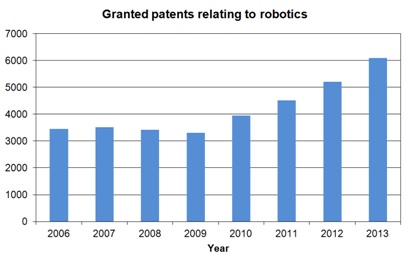25/04/2014
It was recently announced that engineering company Dyson, famous for its cyclonic vacuum cleaners, is to invest £5m over five years in a laboratory dedicated to the study of robotics at Imperial College. With this in mind, what do the future prospects in the field of robotics and associated technology look like, and how does this relate to global trends in intellectual property protection within the sector?
To answer this, a simple search for the number of granted patents published worldwide per year1 making mention of the word ‘robot’ in either the title, abstract, or claims, was carried out. The results, shown in the graph below, are striking.

The number of granted patents published, worldwide, in the field of robotics has clearly seen a dramatic increase since 2009, but appears to have been relatively flat prior to this. The 2013 level is almost double that of 2009, which represents substantial growth in the patent protection granted in this field within a period of only four years. The findings also suggest that, in 2013, the top three countries for obtaining granted patents in robotics were South Korea, the US, and Japan, which between them have a global share of more than 70% of granted patents within the field.
This rise in granted patent protection is indicative of a large-scale increase in robotics research and development, but can consumers expect to see a similar increase in the number of robotics-related products on the market? Robotics technology certainly seems poised to take off in the coming years, and this is borne out by, for example, Google’s recent acquisition of a multitude of robotics companies (see more here and here).
The diversity of potential applications in which robotics can play a part means that consumers can expect to benefit from a wide range of robotics-related products. Key areas are in the manufacturing industry, healthcare, and military applications. Robots also play a crucial role in carrying out tasks in environments which are too hazardous for humans to enter, for example at the site of the Fukushima plant as reported here and here. They are also used for a multitude of research applications, a recent example of which is the Curiosity rover which arrived on the Martian surface in August 2012 and includes a wealth of robotics technology on board.
One important area in which robotics looks set to make an impact is assisting those with limited mobility. Several key companies have been working on the development of human-like robots in order to better understand how to improve technology relating to human movement, and in particular the balance of a moving robot. Of these, Honda’s ASIMO and Toyota’s musically-inclined Partner Robot seem particularly life-like, although we suspect that professional musicians have little to worry about by way of competition for the time being.
What are the future directions for this fast-moving field? Several very recent developments have focussed on so-called ‘soft robotics’ in which the metal hinges, bearings, and screw threads of conventional robotics are replaced by elastically deformable materials actuated by fluid flowing within them. This leads to vast improvements in the variety and efficiency of movements such robots can make. In one impressive example, a robotic fish is reported to be able to execute a direction-changing escape manoeuvre with almost the same speed as its real life counterpart. These developments not only rely on advanced control technology, but advances in the field of materials science are also likely to be essential in researching and understanding materials with suitable properties for soft robotics applications.
Another emerging area is that of nanorobotics. The development of nano-scale robots that can enter the blood stream has the potential to revolutionise targeted drug delivery within living organisms. Recently nanorobots have been demonstrated capable of delivering anti-cancer drugs to a target area of the liver, using an MRI scanner to guide the nano-devices magnetically.
We expect to see applications for patents within these areas in particular increase within the coming years as the technology continues to mature.
- Total Patent
This article is for general information only. Its content is not a statement of the law on any subject and does not constitute advice. Please contact Reddie & Grose LLP for advice before taking before any action in reliance on it.

